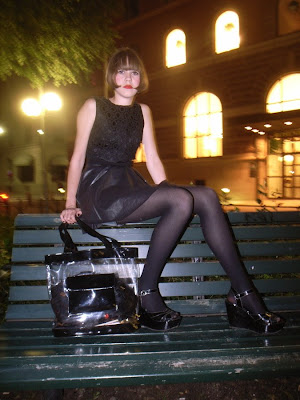
Thursday, August 30, 2007
Wednesday, August 29, 2007
brogues, oxfords, and all of that jazz
I love borrowing from the men. I love androgynous dressing. And for women like me, gents' inspired shoes help complete that look. To perfect that charming man-woman swagger try these.

pic from www.facehunter.blogspot.com
Brogues:
Brogues find their origination in Scotland and Ireland. They are low heeled made of leather and distinguished by the wing tips (the W formation on the toe cap) and the perforations.
Oxfords:
More traditional, formal and plain than brogues. These dress shoes mostly include the little piece of leather stitched at the toe cap.
Look what Miu Miu made for us.
Again, we owe Coco Chanel who brought the two-toned pump into existence for women. She didn't see why men should be so comfortable yet so well dressed all the time and was inspired by a black and white Oxford shoe.




These dance shoes have a split sole just like ballet shoes. They have a longer vamp and is secured to the foot with lacing or elastic. Usually they have a low heel.

pic from www.facehunter.blogspot.com
Winklepickers:
Winklepickers have been around from the 1950's, largely seen in the teddy boys' cultures. It soon found itself adorned by both male and female British rock n roll fans. Winklepickers have a very sharp and long pointed toe and gets it's name from the needle that is used to take out winkles (sea snails) from their shells. Currently a huge fave amongst the Punk/Goth/Emo people.
pic from www.facehunter.blogspot.com
Lastly, you MUST take a peek at Queen Michelle's (Kingdom Of Style) enviable collection of shoes that includes a lot items from above. Click on the link below.
Monday, August 27, 2007
Saturday, August 25, 2007
Friday, August 17, 2007
Monday, August 13, 2007
starting from today
Monday, August 6, 2007
nautical
It is a large umbrella term that encompasses all that is related to marine and naval life. It is easy to spot in terms of interpretations because of the obvious motifs, shapes and silhouettes
deconstruction
In the late 80's a new breed of independent thinking and largely Japanese designers came into force. They were influenced by the minimalism of their own art and culture, and other philosophies which included the literary philosophy of deconstruction by Jacques Derrida. I've tried reading up on the theory of deconstruction, errrm but I'm afraid it's going to take me a while before I get the hang of it... its complicated, understatement. But the base is- to undo/deconstruct/ reconsider/analyse the true meaning of a text which might be repressed otherwise because of the vastness of the language. I suppose it opposes diplomacy in language and stresses on calling a spade a spade, but then again i might be over simplifying the concept.
The designers- Yohji Yamamoto, Rei Kawakubo (Commes Des garcons), Issey Miyake and the non Japanese- Ann Demeulemeester, Dries Van Noten, Maison Martin Margiela largely pioneered the fashion revolution and the love for black.
Ann Demeulemeester
Rei Kawakubo for Commes des Garcons
Dries Van Noten
Maison Martin Margiela
Yohji Yamamoto
These designers delved into history, ecology, physical and cultural changes, progressive thoughts and portrayed their conclusions or emotions in the process of garment construction. They wanted seams and garment components that were previously invisible to be seen.
Though deconstruction early on was largely unfinished and rough around the edges, a newer concept like reconstructed deconstruction has the output looking more whole and finished.
p.s. I doubt one brief post would suffice on this topic. Will probably add more later once I can study in deeper detail.
Subscribe to:
Comments (Atom)


















































